A QR code,
Short for Quick Response code, is a type of two-dimensional barcode that can store a significant amount of information text messaging and QR Codes. It was first developed in 1994 by a Japanese company called Denso Wave, and since then, QR codes have become widely used due to their versatility and ease of use. Here’s some information about QR codes: qr code text
-
Structure and Design:
- QR codes consist of black squares arranged on a white background, typically in a square grid pattern.
- They can be read horizontally or vertically, allowing for flexibility in scanning.
- QR codes can store numeric, alphanumeric, binary, and Kanji (Japanese characters) data.
-
Usage and Applications:
- QR codes are used to encode and provide quick access to information when scanned using a QR code reader or smartphone app.
- They can contain various types of data, such as qr code to text URLs, text, contact information (vCards), Wi-Fi network credentials, payment information, and more text messaging and QR Codes.
- QR codes are widely used for marketing purposes, linking to websites, promotions, discounts, or product information.
- They can be found on product packaging, business cards, posters, flyers, restaurant menus, tickets, and even in digital formats.
-
QR Code Scanning:
- To scan a QR code, you need a smartphone or tablet with a QR code reader app installed. Many modern smartphones have built-in QR code scanners in their camera apps.
- Once the code is scanned, the information stored within it is instantly accessible or triggers an action based on the data it contains.
- The scanning process involves using the smartphone’s camera to capture the QR code image. The app then decodes the information and performs the relevant action.
-
QR Code Generation:
- Several websites and software tools allow you to generate QR codes for free. text messaging and QR Codes You can customize the data, size, design, and color of the QR code to fit your needs.
- When generating a QR code, ensure that it is large enough and has enough contrast for easy scanning.
-
QR Code Security:
- QR codes themselves do not possess built-in security features. Therefore, it’s essential to exercise caution when scanning codes from unknown or untrusted sources.
- Malicious QR codes could potentially redirect users to harmful websites or trigger unwanted actions on their devices. It’s advisable to use a reliable QR code scanning app or enable built-in security features in your device settings.
-
Evolving Standards:
- Over time, QR codes have seen improvements and developments. For instance, the introduction of dynamic QR codes allows for the modification of the encoded data even after the code is generated.
- Newer QR code standards like QR Code 2.0 are capable of storing more data and offer better error correction capabilities.
QR codes have become an integral part of modern technology, providing a convenient way to access information, make payments, and engage with various services. text messaging and QR Codes Their simplicity, versatility, and ease of use have made them popular across different industries and applications.

Text to QR code
Converting text to QR code involves encoding the text as data within the QR code format. text messaging and QR Codes Here’s an overview of the process:
-
Encoding Text:
- The first step is to determine the text you want to encode as a QR code. It can be any alphanumeric text, including numbers, letters, and special characters.
- Ensure that the text does not exceed the maximum capacity of the QR code, as longer texts may require a larger QR code size or may not fit within the available space.
-
QR Code Generation:
- To generate a QR code, you can use various methods, including online QR code text generator, programming libraries, or dedicated software.
- Online QR code generators: Several websites offer free QR code generation services where you can input your text and customize parameters such as size, error correction level, and design.
- Programming libraries: If you’re familiar with programming, text messaging and QR Codes you can use libraries like
qrcodein Python, ZXing in Java, or qrcode.js for JavaScript to generate QR codes programmatically. These libraries often provide flexibility in generating QR codes with specific settings and customization options.
-
QR Code Customization:
- Depending on the tool or library you use, you may have options to customize the QR code’s appearance, error correction level, size, and colors.
- Some tools allow you to select the error correction level, which determines the QR code’s ability to remain scannable even if it is partially damaged or obscured.
- Additionally, you can often choose the size of the QR code based on the amount of data you want to encode. Larger QR codes can store more information but require more scanning space.
-
QR Code Scanning:
- Once you have done text to code generator image, it can be scanned using a QR code reader or a smartphone app equipped with a QR code scanner.
- Users typically open their QR code scanning app, position the QR code within the camera’s viewfinder, and wait for the app to recognize and process the code.
- After scanning, the encoded text is usually displayed or processed based on the application or purpose of the QR code.
QR codes offer a quick and efficient way to encode and decode text data. text messaging and QR Codes They have numerous applications in various industries, including advertising, marketing, payment systems, event management, and inventory tracking.

HTML code generator for TEXT
An HTML code generator for text is a tool or software that allows you to generate HTML code for displaying text on a webpage without the need for manual coding. These generators typically provide a user-friendly interface or form where you can input your desired text and choose various formatting options text messaging and QR Codes. Here’s an overview of how an HTML code generator for text works without requiring coding knowledge:
-
Text Input:
- HTML code generators for text usually have a text input field or a text editor where you can enter the desired text content.
- You can type or paste the text directly into the input area, and the generator will process it.
-
Formatting Options:
- HTML code generators often offer formatting options to customize the appearance of the text.
- Common formatting options include font styles (bold, italic, underline), font sizes, text alignment (left, center, right), and color selection.
- Some generators may also provide additional options such as background color or border styling for the text text messaging and QR Codes.
-
Live Preview:
- Many HTML code generators have a live preview feature that allows you to see the changes in real-time as you modify the text and formatting options.
- The live preview provides an immediate visual representation of how the generated HTML code will render on a webpage.
-
Code Generation:
- Once you have inputted your desired text and chosen the formatting options, the HTML code generator will generate the corresponding HTML code based on your selections.
- The generated HTML code is usually displayed in a separate area or provided as a downloadable file.
-
Copy and Paste:
- After the HTML code is generated, you can typically copy it to the clipboard with a click of a button.
- The generated code can then be pasted into your own HTML document, content management system, text messaging and QR Codes or website builder to display the text with the chosen formatting.
-
Customization and Advanced Options:
- Depending on the HTML code generator, you may have additional customization options available, such as advanced styling using CSS or the ability to include additional HTML elements around the generated text.
- Some generators may offer more complex features, such as generating code for interactive text elements like buttons or tooltips.
HTML code generators for text provide a convenient way for users without coding knowledge to create and customize formatted text for webpages text messaging and QR Codes. They eliminate the need to manually write HTML code and allow you to focus on the content and visual aspects of your text.
How to convert a text into QR code in PHP
To convert a text into a QR code using PHP, you can follow these general steps:
-
Install the PHP QR Code library:
- Begin by downloading and installing the PHP QR Code library from a trusted source. This library provides the necessary functions to generate QR codes in PHP.
- Ensure that you have the appropriate permissions and dependencies set up to use the library in your PHP environment text messaging and QR Codes.
-
Include the QR Code library:
- In your PHP script, include the QR Code library files to access its functions and classes.
- This is typically done using the
require_onceorincludestatement with the file path to the QR Code library.
-
Set the text to encode:
- Determine the text you want to encode as a QR code.
- It can be any alphanumeric text, such as a URL, plain text message, contact information, or any other data you wish to represent in the QR code.
-
Generate the QR code:
- Utilize the functions provided by the QR Code library to generate the QR code based on the text you want to encode text messaging and QR Codes.
- The library will handle the encoding and creation of the QR code image.
-
Specify output options:
- Decide how you want to use or present the generated QR code.
- You may choose to save the QR code as an image file or display it directly on a webpage.
-
Save the QR code (optional):
- If you want to save the QR code as an image file, specify the output file name, format, and location.
- Ensure that the appropriate permissions are set to allow the PHP script to write the image file.
-
Display the QR code (optional):
- If you prefer to display the QR code directly on a webpage, you can embed it using an HTML
<img>tag. - Set the
srcattribute of the<img>tag to the path or URL of the generated QR code image.
- If you prefer to display the QR code directly on a webpage, you can embed it using an HTML
By following these steps and utilizing the PHP QR Code library, you can convert a text into a QR code in PHP text messaging and QR Codes. The library handles the encoding process and provides the necessary functions to generate the QR code image.
